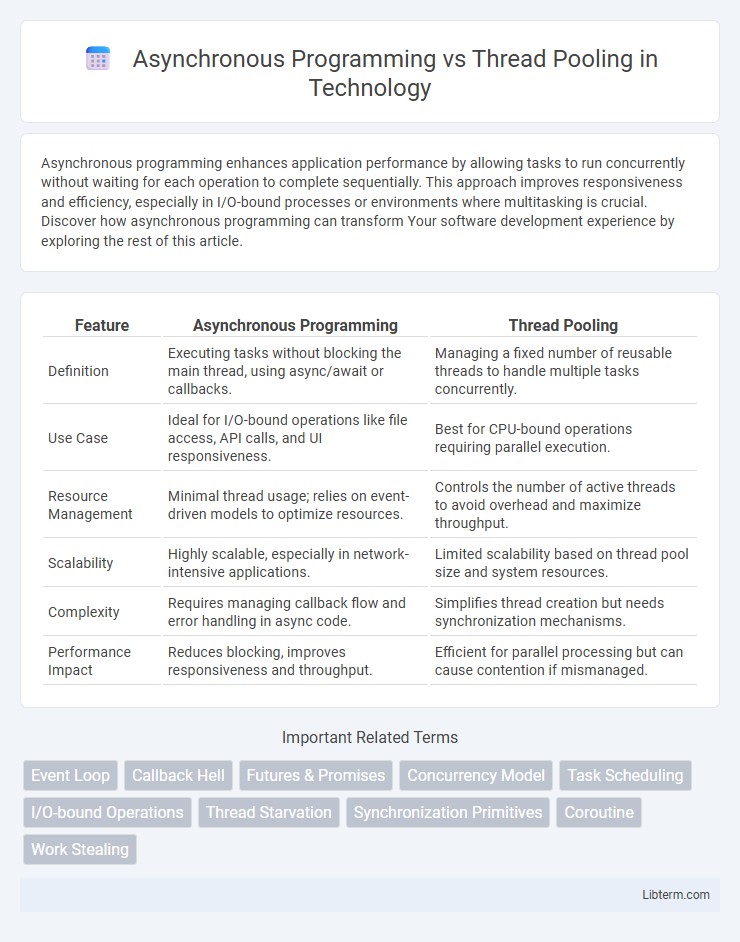Asynchronous programming enhances application performance by allowing tasks to run concurrently without waiting for each operation to complete sequentially. This approach improves responsiveness and efficiency, especially in I/O-bound processes or environments where multitasking is crucial. Discover how asynchronous programming can transform Your software development experience by exploring the rest of this article.
Table of Comparison
| Feature | Asynchronous Programming | Thread Pooling |
|---|---|---|
| Definition | Executing tasks without blocking the main thread, using async/await or callbacks. | Managing a fixed number of reusable threads to handle multiple tasks concurrently. |
| Use Case | Ideal for I/O-bound operations like file access, API calls, and UI responsiveness. | Best for CPU-bound operations requiring parallel execution. |
| Resource Management | Minimal thread usage; relies on event-driven models to optimize resources. | Controls the number of active threads to avoid overhead and maximize throughput. |
| Scalability | Highly scalable, especially in network-intensive applications. | Limited scalability based on thread pool size and system resources. |
| Complexity | Requires managing callback flow and error handling in async code. | Simplifies thread creation but needs synchronization mechanisms. |
| Performance Impact | Reduces blocking, improves responsiveness and throughput. | Efficient for parallel processing but can cause contention if mismanaged. |
Introduction to Asynchronous Programming and Thread Pooling
Asynchronous programming enables efficient execution by allowing tasks to run concurrently without blocking the main thread, improving application responsiveness and resource utilization. Thread pooling manages a collection of pre-instantiated threads to execute multiple tasks, reducing the overhead of thread creation and destruction. Combining asynchronous programming with thread pooling optimizes performance in I/O-bound and CPU-bound operations by balancing concurrency and resource management.
Core Concepts: How Asynchronous Programming Works
Asynchronous programming enables non-blocking operations by allowing tasks to run independently of the main execution thread, utilizing callbacks, promises, or async/await patterns to manage task completion. It improves application responsiveness by freeing the main thread to handle other tasks while waiting for operations like I/O or network requests to finish. Unlike thread pooling, which manages a fixed number of threads for concurrent execution, asynchronous programming leverages event loops or message queues to efficiently handle multiple operations without creating new threads.
Understanding Thread Pooling: Key Mechanisms
Thread pooling optimizes resource management by maintaining a collection of reusable threads that handle multiple tasks concurrently, reducing the overhead of thread creation and destruction. Key mechanisms include a queue for incoming tasks, worker threads that pull tasks from the queue, and synchronization techniques to manage thread safety and task scheduling. Efficient thread pooling improves application scalability and responsiveness, especially in high-concurrency scenarios.
Performance Comparison: Async Programming vs Thread Pools
Asynchronous programming improves scalability by allowing non-blocking operations, efficiently utilizing system resources without creating multiple threads, which reduces context switching overhead. Thread pooling enhances performance by reusing a fixed number of threads to execute tasks concurrently, minimizing the overhead of thread creation but potentially causing thread starvation under heavy load. In high I/O-bound workloads, async programming often outperforms thread pooling due to better resource utilization, while CPU-bound tasks may benefit more from thread pools managing parallel execution.
Resource Management in Asynchronous vs Threaded Environments
Asynchronous programming optimizes resource management by allowing tasks to run without blocking threads, enabling efficient CPU utilization and reduced memory overhead in high-concurrency environments. Thread pooling manages resources by reusing a fixed number of threads to execute multiple tasks, reducing thread creation costs but potentially causing thread starvation under heavy load. Effective resource management in asynchronous models minimizes context switching and maximizes scalability, whereas thread pooling requires careful tuning to balance thread availability and system responsiveness.
Scalability: Which Approach Handles More Tasks?
Asynchronous programming enables better scalability by handling thousands of concurrent tasks without blocking threads, making it ideal for I/O-bound operations. Thread pooling improves resource management by reusing a limited number of threads, reducing overhead but is constrained by the fixed pool size, limiting scalability under heavy loads. For high scalability and efficient handling of large-scale, concurrent tasks, asynchronous programming outperforms thread pooling.
Error Handling Differences in Both Models
Error handling in asynchronous programming relies on capturing exceptions through constructs like try-catch within async methods or using continuation tasks to manage errors without blocking threads. Thread pooling error handling involves catching exceptions within worker threads, with unhandled exceptions potentially terminating the entire thread or application if not properly managed. Asynchronous models offer more granular error propagation tied to task completion, whereas thread pooling demands explicit error management to prevent unexpected thread termination and resource leaks.
Use Cases: When to Choose Asynchronous Programming
Asynchronous programming is ideal for I/O-bound operations such as web requests, file handling, and database queries where tasks spend significant time waiting for external resources. It improves application responsiveness by releasing threads during wait times, making it suitable for UI applications, servers handling numerous simultaneous connections, and real-time data processing. Choosing asynchronous programming over thread pooling ensures efficient resource utilization and scalable performance in environments with high I/O latency.
Use Cases: When to Opt for Thread Pooling
Thread pooling is ideal for scenarios requiring efficient management of limited resources and predictable task execution, such as handling numerous short-lived concurrent tasks in server applications. It enables controlled parallelism by reusing a fixed number of threads, reducing overhead and avoiding thread exhaustion in CPU-bound or blocking operations. Choose thread pooling when tasks are compute-intensive or involve I/O that benefits from thread reuse without the complexity of asynchronous state machines.
Best Practices and Common Pitfalls
Asynchronous programming improves application responsiveness by allowing tasks to run without blocking the main thread, while thread pooling efficiently manages a limited number of threads to reduce overhead. Best practices include avoiding thread starvation in thread pooling by configuring optimal pool sizes and preventing deadlocks in asynchronous code by careful use of synchronization contexts. Common pitfalls involve misusing async-await patterns leading to unobserved exceptions and exhausting thread pools with long-running synchronous operations.
Asynchronous Programming Infographic

 libterm.com
libterm.com